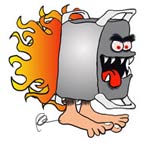|
Theoretically,
USB 2.0 should be faster than FireWire. But that
may not be so in real life. WiebeTech
has released a combo drive (Desktop GB) that
supports both FireWire and USB 2.0. It made the
perfect test unit for comparing the speed of USB
2.0 to FireWire.
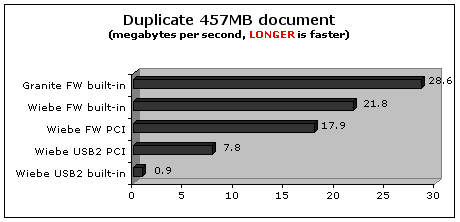
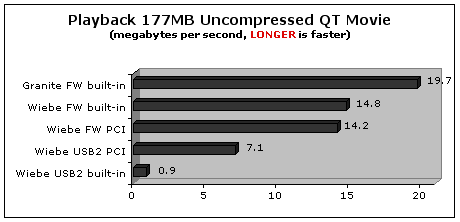
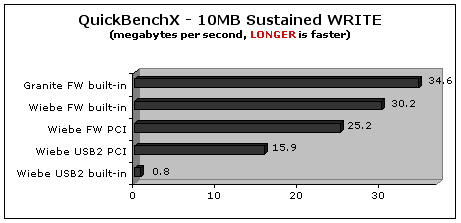
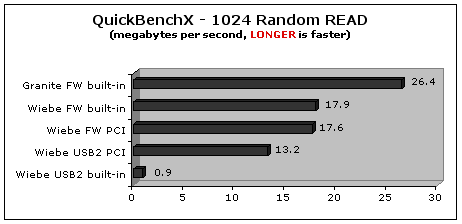
NOTE:
"USB2 built-in" on the graphs above means that the
USB 2.0 port on the drive was connected to the
Power Mac's built-in USB port. But since the
built-in port is only USB 1.1, the drive's
interface speed dropped to under
1MB/sec.
CONCLUSION
USB
2.0 is much faster than USB 1.1 but it is much
slower than FireWire, at least in the case of the
WiebeTech
drive I used.
(Note:
USB 2.0 is only faster than USB 1.1 if you are
running OSX and have a USB 2.0 PCI card with USB
2.0 drivers.)
Even
if USB 2.0 ran at the same speed as FireWire, it
has two big disadvantages:
1. You can't boot from USB 2.0 drives
2. USB devices have to share the bandwidth and
slower devices pull down the speed of faster
ones.
In
the great battle between Intel's USB and Apple's
FireWire, we're at a crucial point. Even if
FireWire wins on pure performance, USB 2.0 could
win on sheer numbers of devices using it. USB has
its place. FireWire is overkill for printers. But
it would be perfect for the new digital still
cameras. Yet it hasn't caught on like it did with
digital video cams.
Fight
on Apple, fight on.
As
a consumer, I'd like to see Apple implement USB 2.0
internally and give us 800 megabit FireWire at the
same time.
If
you want the versatility of running either FireWire
or USB 2.0, the WiebeTech
Desktop GB is the way to go.
TEST
NOTES
Test
"Mule" was an Apple
Power Mac Dual G4/800 which features dual USB 1.1
channels and single FireWire channels (2
ports).
Main
Test Drive was the WiebeTech
120GB Desktop GB with one USB 2.0 port and two
FireWire ports.
Since
the built-in USB ports on the Power Mac are USB
1.1, I used the Orange Micro USB 2.0 PCI card that
WiebeTech provided. (Orange
Micro
declined to send me one. Don't ask me why.) I also
tested the USB 2.0/FireWire Combo PCI card from
FirewireDirect.
It comes with Orange Micro drivers and produced
identical performance to the Orange Micro
board.
I
also tested it using the built-in USB ports just to
show how slow USB 1.1 is compared to USB
2.0.
To
be fair, I tested the FireWire port on the
WiebeTech drive using a FWDepot.com
FireWire PCI card since, in past testing, the
transfer speeds are lower than that of the built-in
FireWire ports of the Power Mac.
Finallly,
I included results from a Granite
Digital
FireWire case kit with a Western Digital drive
similar to the one used in the WiebeTech to show
how its FireWire performance compares to the top
performing case kit.
For this report I used QuickBenchX (beta 5) courtesy of Intech.
It's currently the only OS X disk benchmarking
software that doesn't give bogus numbers for
sustained and random read/writes. Even though it's
technically not a "real world" application, it
provides very realistic results.
WHERE TO ORDER YOUR APPLE PRODUCTS
When ordering products from Apple Store USA, please click THIS TEXT LINK or any Apple display ad as your "portal" to the online store. In so doing, you help to support Bare Feats.
© 1995-2007 Rob Art Morgan
"BARE facts on Macintosh speed FEATS"
Email
, the webmaster
|
